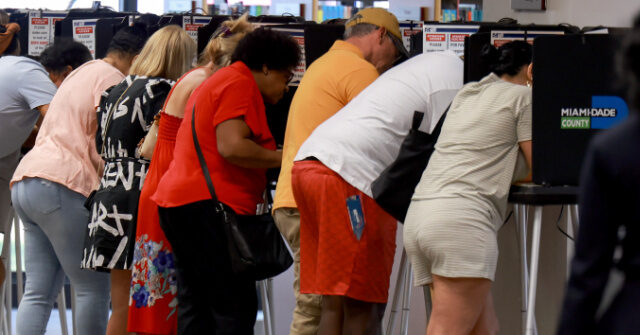As of a recent report, Republicans in Florida have significantly outpaced Democrats in early voting for the upcoming presidential election, demonstrating a considerable advantage in voter turnout. By Friday afternoon, nearly 800,000 more ballots had been cast by Republicans compared to their Democratic counterparts. Total early and mail-in votes reached approximately 7.1 million, with Republicans accounting for about 44.39% of the ballots cast, while Democrats garnered only 32.78%. This trend reflects Republicans’ strength and strategic advantage, particularly in early in-person voting, where they led 2.2 million to 1.2 million. Meanwhile, Democrats demonstrated a slight preference for mail-in voting, achieving around 1.1 million votes compared to 948,000 for Republicans. This early voting data highlights a shifting landscape in Florida’s electoral dynamics, as the Republican Party appears to be mobilizing its base effectively.
Florida’s overall voter turnout for the presidential election stands at 50% of registered voters, with a total of 13,845,913 registered individuals in the state. This turnout rate underscores the competitive nature of Florida’s elections, a state often described as a swing state due to its history of fluctuating voter support between parties. In the past, Presidents Obama and Trump have both claimed victories in Florida, illustrating its pivotal role in national elections. However, the Republican Party has made significant strides in recent years, gaining an expanding grip on voter registration and participation. The data shows Republicans currently leading in registration with over one million more registered voters than Democrats, which is a stark contrast to previous election cycles.
The shift in voter registration advantages has been dramatic in Florida over the last few years. In 2020, Democrats held the upper hand with 5,315,954 registered voters compared to 5,218,739 Republicans. Fast forward to 2024, and the numbers have flipped decisively, with Republicans at 5,455,480 and Democrats at 4,400,561. This growth by the Republican Party highlights a strategic shift among Florida voters, raising concerns about the Democratic Party’s capacity to mobilize support effectively in future elections. The voter registration data reveals a trend where Republicans have consolidated their position, successfully attracting new voters to outweigh the traditional Democratic base in the state.
Recent polling further emphasizes the Republican Party’s dominance in Florida as former President Donald Trump appears to be leading current Democratic candidate Kamala Harris by a notable margin. A survey from the University of North Florida’s Public Opinion Research Lab revealed Trump with 53% support compared to Harris’s 43%, which reflects a ten percent lead. Additionally, Trump’s appeal among key demographic groups, such as women and Hispanic voters, showcases a nuanced understanding of the state’s diverse electorate. This data is corroborated by the latest RealClearPolitics average of polls, where Trump maintains an 8.5% lead over Harris, affirming the Republican Party’s stronghold in this crucial swing state.
Moreover, historical context reveals that Trump narrowly won Florida in both 2016 and 2020, securing victories by 1.2% and 3.3%, respectively. His ability to capture Florida has been instrumental in his previous campaigns, underscoring the state’s critical electoral votes. With the current polling indicating a solid lead over his Democratic opponent, the 2024 election landscape suggests that Trump continues to resonate with the Florida electorate, leveraging both his past victories and the Republican infrastructure that has flourished in recent years. This situation raises questions about the Democratic Party’s strategies moving forward, particularly regarding outreach and engagement efforts aimed at reclaiming lost ground.
As the presidential election approaches, the implications of these trends and voter patterns in Florida become increasingly significant. The state’s evolving demographics, coupled with the shifting political loyalties, present both challenges and opportunities for candidates. For Republicans, the enhanced voter registration and early voting enthusiasm suggest a well-organized supporting base that could prove vital for upcoming campaigns. Conversely, for Democrats, the 2024 election serves as a critical juncture to reassess strategies and bolster their outreach to regain competitive footing in Florida, a state that historically plays a decisive role in determining the outcome of presidential races. As both parties prepare for the election, Florida will undeniably remain a focal point for political engagement and voter mobilization efforts, setting the stage for a potentially impactful election cycle.

